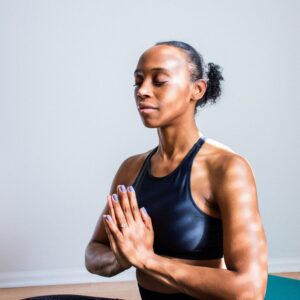
Those new to meditation may find it challenging, not only to feel successful in their practice but also to maintain consistency.
It’s totally normal for beginners to experience discomfort or frustration when exploring meditation because meditation is a skill that you only get better at with practice. And it’s definitely about progress over perfection.
The challenge can prevent many from even getting started. Only about 14 percent of Americans have meditated at least once.
You may experience boredom, restlessness, doubt and other feelings that can be challenging in the beginning. But sitting with your mind and helping to flex that control muscle is full of benefits, such as stress management, creativity boost, increased patience and more.
Specifically, about 53 percent of people who meditate say it improves memory and concentration, and meditation is thought to reduce insomnia by as much as 50 percent.
The following are 14 tips to help you build a solid meditation foundation for an overall better experience that you can stick with.
Start early
It’s helpful to meditate first thing in the morning if you can. Doing so can ensure that you actually do it before the day gets more hectic.
Morning meditations are also a great way to start the day! Feel free to pair it with a glass of lemon water before or after for an added health bonus.
Commit to consistency
To build your meditation practice into a habit, it’s helpful to commit to doing it at the same time each day. If that’s not in the morning, when is a good time that makes sense for you?
Including meditation as a regular part of your day-to-day life is the best way to make it a lasting habit.
It’s OK if your mind wanders
Often, many beginners feel like meditation should feel like waving a magic wand for instant focus and relaxation. This isn’t the care, but that’s OK.
Your mind will naturally wander, but instead of getting frustrated, use that as an opportunity to flex that mental self-control muscle. Every time your mind wanders, pull it back. Even if that’s 100 times in five minutes, your effort is worthwhile and something that can strengthen over time.
Get creative about the location
While it can help to meditate in the same place daily for consistency, don’t be afraid to break out of the mold now and then. In addition, you might not be able to meditate in the same location every day. And that’s OK.
Fortunately, you can meditate just about anywhere, whether that’s at home, work, a park or elsewhere. The key is that you can find stillness and not be disturbed.
Of course, if there’s an easy place in your home where you can reduce clutter and promote stillness and focus, that’s perfect as well.
Explore comfortable positions
Don’t worry about the stereotypical images of people sitting cross-legged to meditate if that position is uncomfortable (or even distracting) for you. In fact, many find it uncomfortable, so you’re not alone.
You don’t have to force yourself to sit up too straight since that could force your mind to be too uptight. You can sit in a chair or on a couch. Your arms and legs can be uncrossed, with your feet flat on the floor. Also, feel free to place a cushion or rolled-up towel underneath your backside if that helps set the back naturally upright.
Take the time to experiment with different positions to identify what works best for you.
Breathe naturally
While meditation involves focusing on your breath and using it to focus your mind, don’t stress about the breath specifically or try to alter it.
Your best approach is to allow for natural breath, and notice the rising and falling sensations it creates in your body.
Embrace discomfort
Whether you’re new to meditation or have been practicing for years, it’s not uncommon to experience anxiety, restlessness or even irritation. But don’t try to resist these emotions. Instead, give them your full attention and allow them to come and go.
By doing so, your mind will learn to recognize them for what they are and not get caught up in negative patterns of thoughts. Of course, this is a skill that’s beneficial outside of meditation as well.
Start with short meditations
Baby steps. Baby steps are critical for building new habits that can be sustained. Your first meditation does not need to be 60 minutes long or even 30 minutes long.
Instead, start short and build up over time. Start with 2-minute meditations. Then, when you feel ready, try 5-minute meditations and so on.
This is important because if you set the initial goals too high where they don’t feel achievable, you’ll just feel frustrated. Focus on achievable goals, and give yourself grace as you build up to longer meditation practices.
Try guided meditations
If you’re looking for a little help, there are many guided meditations out there, whether they’re on YouTube, podcasts or even meditation apps. Meditation-specific music may also be appealing.
Search around and see what might appeal to you. If one doesn’t suit you, keep looking until you find something that works. Everyone is different, so a bit of trial and error is necessary.
End your meditations slowly
While your daily to-do list might be knocking at the metaphorical door, don’t dive right into your day at the end of your meditation. Allow yourself to end your practice slowly.
This will be different for everyone, but it could include some light initial movement, stretches or anything else. Give yourself the time to enjoy the benefit of meditation. Don’t rush out into your day as if the practice never happened at all.
Check-in with yourself after meditation
After each meditation practice, take a moment to tune into how you feel physically, emotionally and mentally.
Does your mind feel clearer? Are you calmer? Are you more focused?
The more you understand how meditation is impacting you, the more committed you’ll be to meditating consistently.
Record any excuses to not meditate
If you decide not to meditate, write down the reasoning for not meditating that day. This can benefit you because you’ll notice any trends. But in addition, the act of writing down any excuses will help minimize it and make it less likely of an excuse in the future.
Especially when you compare a written-down excuse to the importance of your mental health, you’ll more than likely resist excuses more and more.
Find an accountability partner
Accountability partners are fantastic in all health and fitness activities, whether that’s meal prepping, working out and so on.
You don’t have to meditate together or even at the same time. But if you have someone to check in with daily who’s also looking to meditate consistently, this will help keep you on track and resist personal excuses to not meditate.
No judgment
Resist the temptation to judge any meditation practice as good or bad or even whether you’re improving.
Sometimes, when we’re eager to see progress, we can feel like something might not be worth doing if we don’t see “enough” progress. But meditation is far more subjective than that. Definitely take note of how you feel afterward, but don’t feel like you should walk away from meditation with deep insights or dramatic life shifts.
Stay present in the moment, just like you’re striving to do in your meditation practice.
In conclusion
Meditation is not an all-or-nothing experience. There are ebbs and flows in every practice. Remember to be patient with yourself, and keep all the health benefits of meditation in mind. Your effort is worthwhile.
Learn more about meditating with this Meditation 101 video by Kaia FIT founder Nikki Warren.
Kaia FIT is a women’s fitness and nutrition program that empowers women to become the best version of themselves through personalized coaching in a group environment. We prioritize community to help connect women to each other for additional support and accountability. Caren Roblin is the owner of Kaia FIT Sierra, with four studio locations in Reno-Sparks.




